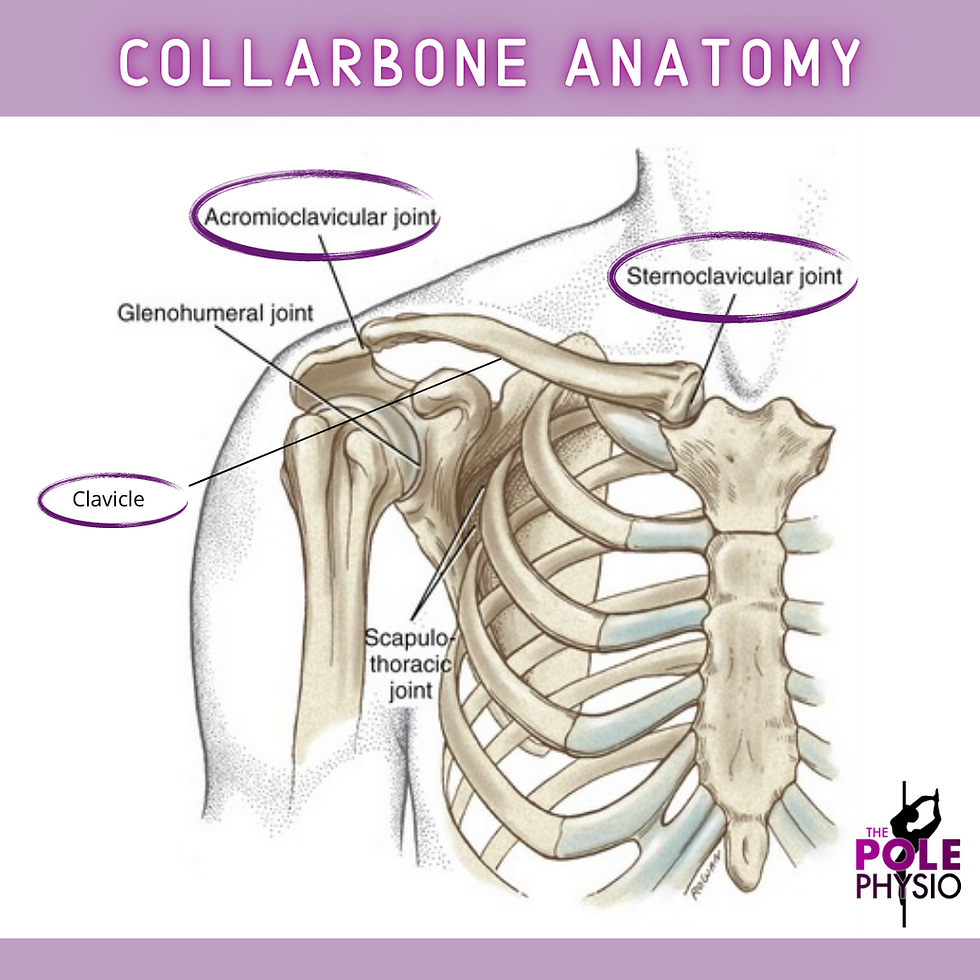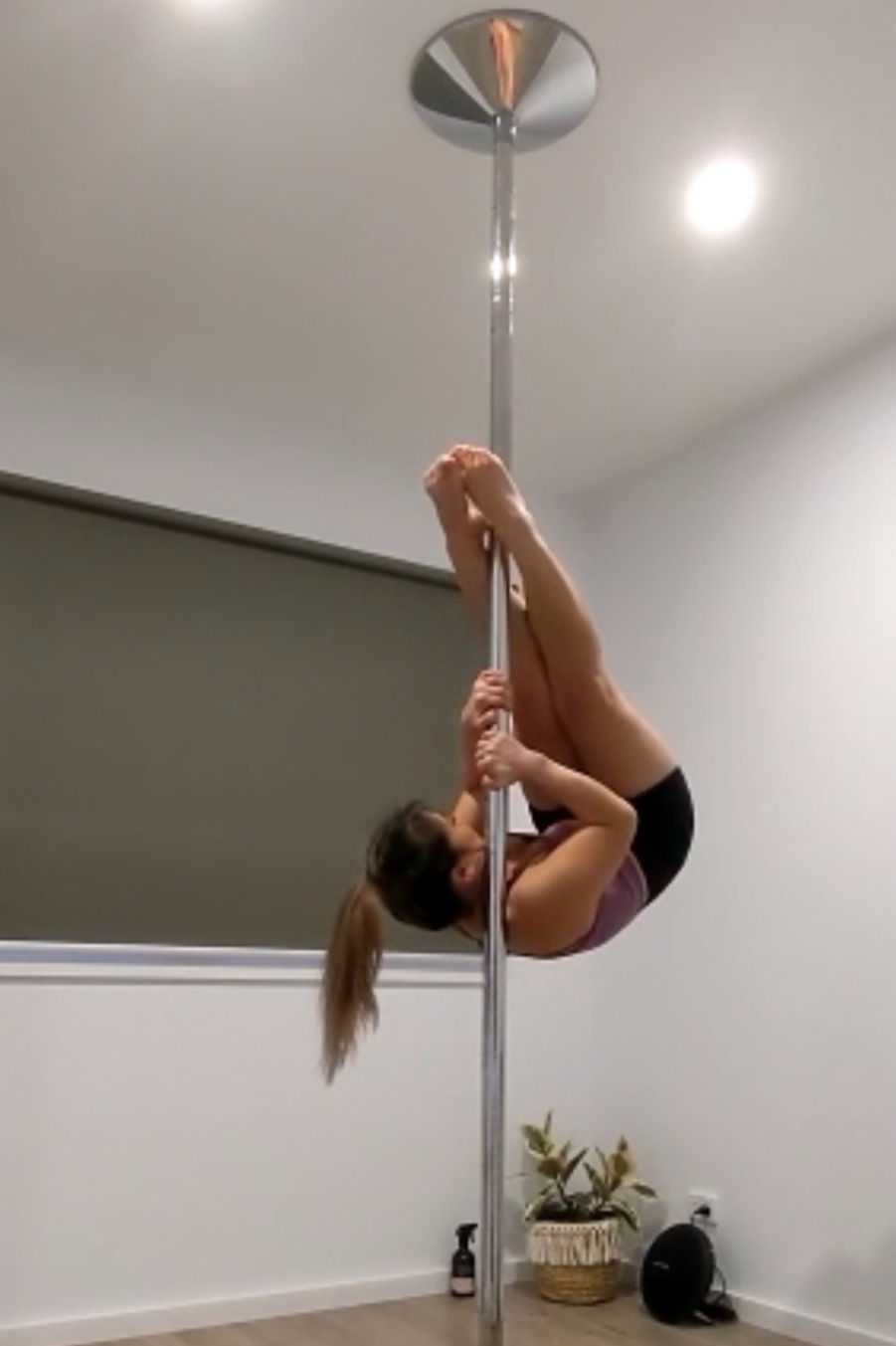Learning new pole tricks comes with the incredible excitement of feeling strong in a new move and well… new pole kisses too! Remember that first time you hung out in an outside leg hang and a week later it still looked like you got kicked in the back of the leg? Well, this is an all too common feeling when learning how to shoulder mount, except this time the bruises and pain are sitting a little higher up towards the collarbone.
In today’s blog we are going to discuss the anatomy of the collarbone, break down common AC joint injuries and what we can do to avoid this pain whilst shoulder mounting! Let’s get to it!
Anatomy
The collarbone (aka clavicle), is located between our breast bone (sternum) and the shoulder blade (scapula) and connects to the body via the shoulder bone known as the humerus. It’s one of the first bones to be created in a foetus and one of the last ones to completely fuse around the age of 25. This bone not only allows movement of the shoulder blade to occur, but it acts as a strut for the upper body whilst playing the vital role of protecting some key blood vessels and the nerve supply to the arms (brachial plexus – medially).

The collarbone connects to the breastbone via the sternoclavicular joint, and to the shoulder via the acromioclavicular joint also known as the AC joint. Both of these joints serve the very important role of suspending and transferring forces from the whole upper arm from the trunk. Any injury to these joints can result in some real disability.
Pole Injuries
In pole, specifically with shoulder mounts, there can be a variety of injuries that occur to this area when things go wrong. We are going to briefly break down the most relevant three injuries for pole dancers now:
AC joint sprains
AC joint sprains commonly occur from direct trauma to the joint such as a fall onto the area out of a shoulder mount – ouch! This may result in mild to severe tearing of the ligament. The milder injuries (grade 1-3) can usually be conservatively managed with a good physio, whereas grade 4-6 usually require surgical intervention in addition to physiotherapy/rehabilitation.
Clavicle bone bruise
Bruises in bone commonly occur in pole from incorrect technique or a nasty knock to the surface from a fall that doesn’t result in fracture or sprain. This type of injury can generally be avoided with correction of technique and physiotherapy guided rehabilitation. Hold on tight as we will discuss correct shoulder mount technique shortly!
Distal AC joint osteolysis
Lastly these types of injuries are classified as repetitive microfracture of the clavicle resulting in sharp pain in the AC joint. As each microfracture attempts to heal, the bone is remodelled in a jagged and uneven way, placing considerable stress on the AC joint, heading into a deteriorative state. This injury is common in pole dancers and weightlifters due to the heavy overhead pushing force we exert on the shoulder. This injury, when caught early, can be conservatively managed well with physiotherapy. Some more severe cases may require surgical management.
Rehab
Regardless of the injury, they all have the same thing in common to fix the issue – rehab! Your physiotherapist can assist you in determining the cause of your injury and addressing any technique and strength-based issues in your rehab program. Alternatively, appointments can be made online with The Pole Physio to assist with these injuries.
Getting collarbone pain when you're transitioning from your shoulder mount to front crucifix (inverted leg hook) ???
When starting out learning to shoulder mount it can be helpful to manoeuvre your body on the pole in certain ways to reduce contact on the collarbone.
To reduce collarbone contact in this transition aim to:
keep the back as straight as possible
drive the hips up the pole to hook the knees high up.
A curved spine and low leg hook will increase collarbone contact as you transition from the mount to crucifix position.


What about when you're exiting your shoulder mount?
To reduce collarbone contact on your exit:
1. Place your hands at belly button height on the pole
2. Drive your shoulders & chest towards your knees by actively crunching your abs. This point is key!
3. Push your hips away from the pole (safety first!) and straight your legs to an ankle hook position
4. When safe to take the feet off the pole keeping your hips away from the pole and towards the floor at all times.




And remember: this information does not replace a teacher or a spot when learning to shoulder mount exit. It can be used in conjunction to your teacher's instructions.
Magic right!?
Well there you have it, everything you need to know about collarbone based injuries for today.
Are you recovering from a collarbone based injury and can’t seem to make it back to the pole? Or just not sure where you’re going wrong with your pole technique?
Online telehealth appointments can be booked with the Pole Physio via our ‘Book Online’ page that can be found here. Assessment and tailored rehabilitation are provided in accordance with best practice and evidence-based treatment to help you unleash your 'poletential'.
Until next time, train safe
The Pole Physio
x
Click here provide members with discounts on over-the-counter medications, vitamins, and health essentials, promoting better health management and cost-effective wellness solutions. kaiserotcbenefits.com - more details here
Click here help you find recent death notices, providing information about funeral services, memorials, and tributes for loved ones in your area. obituariesnearme.com - more details here
Click here? Many users have had mixed experiences with the platform, so it's important to read reviews and verify deals before booking. istravelurolegit.com - more details here
AV在线看 AV在线看;
自拍流出 自拍流出;
国产视频 国产视频;
日本无码 日本无码;
动漫肉番 动漫肉番;
吃瓜专区 吃瓜专区;
SM调教 SM调教;
ASMR ASMR;
国产探花 国产探花;
强奸乱伦 强奸乱伦;
代发外链 提权重点击找我;
谷歌蜘蛛池 谷歌蜘蛛池;
Fortune Tiger…
Fortune Tiger…
谷歌权重提升/ 谷歌权重提升;
谷歌seo 谷歌seo;
谷歌霸屏 谷歌霸屏
蜘蛛池 蜘蛛池
谷歌快排 谷歌快排
Google外链 Google外链
谷歌留痕 谷歌留痕
Gái Gọi…
Gái Gọi…
Dịch Vụ…
谷歌霸屏 谷歌霸屏
负面删除 负面删除
币圈推广 币圈推广
Google权重提升 Google权重提升
Google外链 Google外链
google留痕 google留痕
代发外链 提权重点击找我;
谷歌蜘蛛池 谷歌蜘蛛池;
Fortune Tiger…
Fortune Tiger…
谷歌权重提升/ 谷歌权重提升;
谷歌seo 谷歌seo;
谷歌霸屏 谷歌霸屏
蜘蛛池 蜘蛛池
谷歌快排 谷歌快排
Google外链 Google外链
谷歌留痕 谷歌留痕
Gái Gọi…
Gái Gọi…
Dịch Vụ…
谷歌霸屏 谷歌霸屏
负面删除 负面删除
币圈推广 币圈推广
Google权重提升 Google权重提升
Google外链 Google外链
google留痕 google留痕
代发外链 提权重点击找我;
蜘蛛池 蜘蛛池;
谷歌马甲包/ 谷歌马甲包;
谷歌霸屏 谷歌霸屏;
谷歌霸屏 谷歌霸屏
蜘蛛池 蜘蛛池
谷歌快排 谷歌快排
Google外链 Google外链
谷歌留痕 谷歌留痕
Gái Gọi…
Gái Gọi…
Dịch Vụ…
谷歌霸屏 谷歌霸屏
负面删除 负面删除
币圈推广 币圈推广
Google权重提升 Google权重提升
Google外链 Google外链
google留痕 google留痕